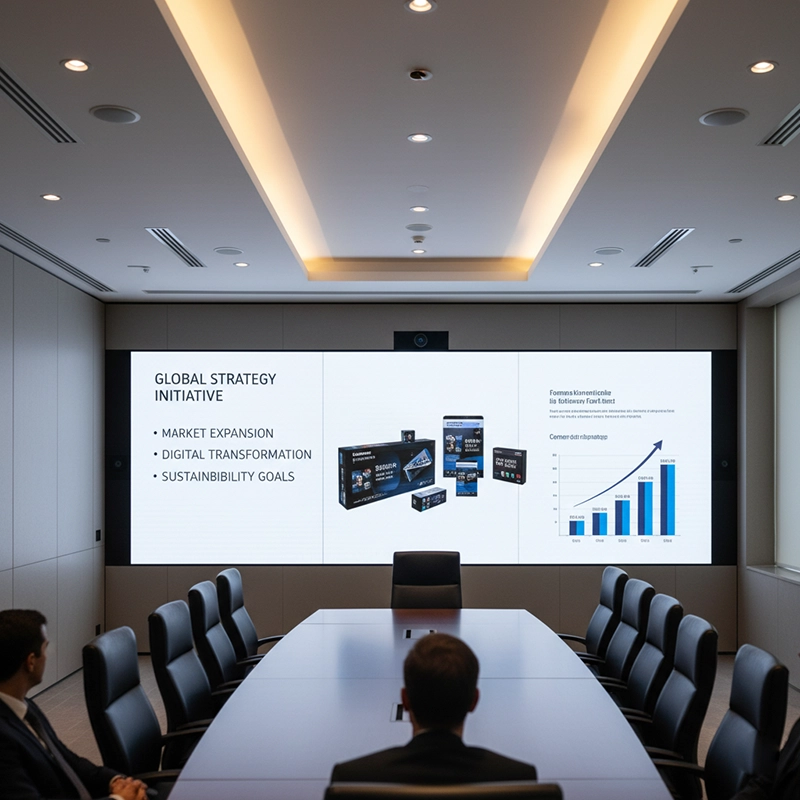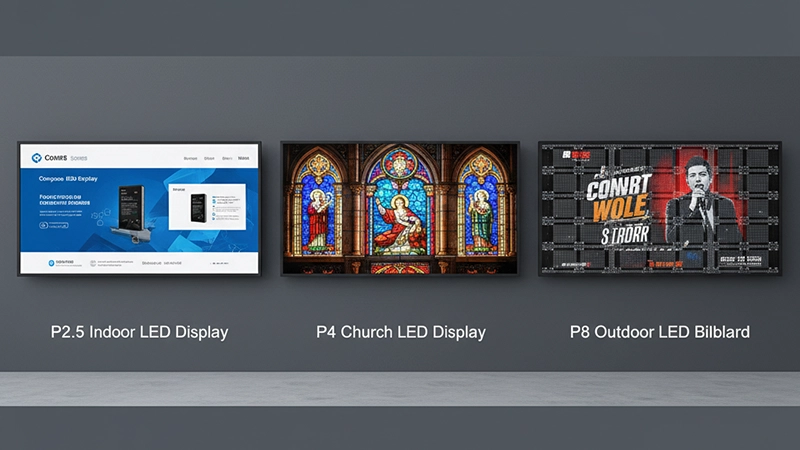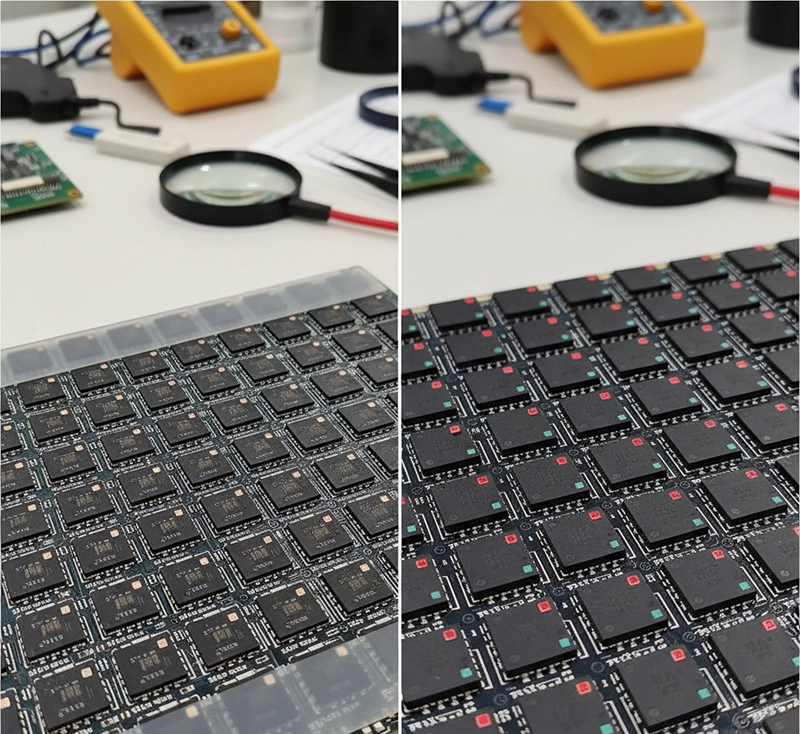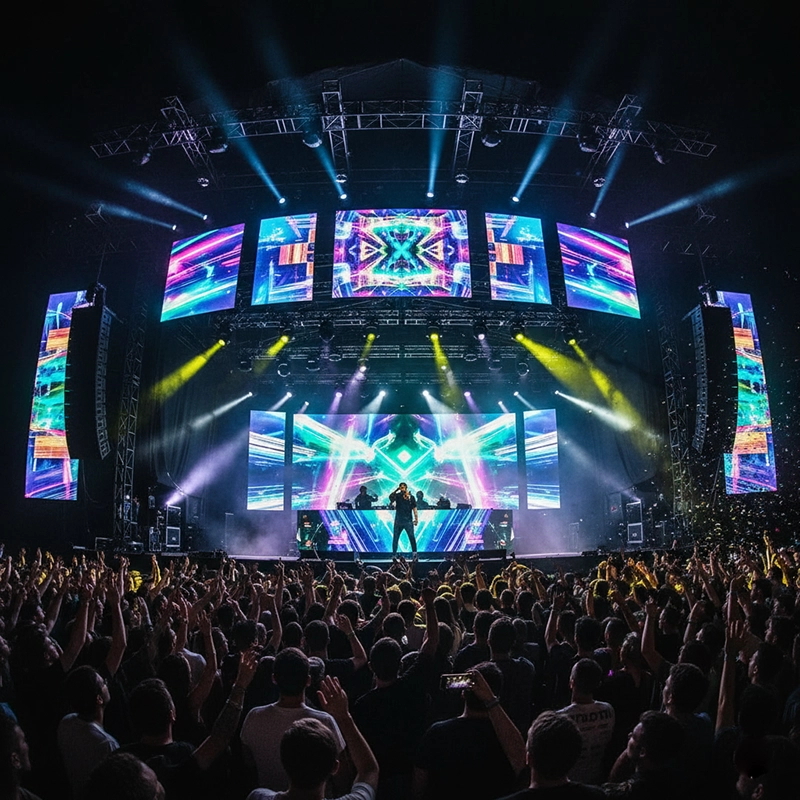The cost of an LED video wall in 2025 is primarily determined by pixel pitch, screen size, installation type, LED packaging technology, and additional system features. On average, buyers should expect to pay between $800 and $2,500 per square meter. Fine-pitch indoor displays for broadcast studios and control rooms sit at the upper end of the price spectrum, while large-pitch outdoor LED displays for billboards or stadiums are more cost-effective per square meter. Hidden expenses such as control systems, installation labor, and long-term maintenance also play significant roles in shaping the total investment.
Pixel pitch remains the single most influential factor in LED video wall pricing. Pixel pitch refers to the distance in millimeters between two adjacent LED pixels. The smaller the pitch, the higher the pixel density and resolution, but also the greater the cost per square meter.
Ideal for corporate boardrooms, mission-critical control centers, and TV studios.
Average pricing ranges from $2,000–$2,500 per sqm depending on brightness and refresh rate.
Growing demand in conference centers and broadcast environments has kept costs relatively high despite manufacturing improvements.
Common in retail stores, churches, and multi-purpose rental LED screen applications.
Average price between $1,200–$1,800 per sqm.
Balance of visual clarity and affordability makes it the most widely purchased category.
Typical for stadium display solutions, outdoor LED billboards, and public squares.
Pricing is more affordable, often $800–$1,200 per sqm.
Durability, weatherproofing, and brightness features can shift the final cost more than resolution itself.
| Pixel Pitch Category | Common Application | Price Range (per sqm) | Заўвагі |
|---|---|---|---|
| P0.6 – P2.5 | Indoor LED Display, studios, control rooms | $2,000 – $2,500 | Highest resolution, premium costs |
| P3 – P5 | Church LED displays, retail, Rental LED screen | $1,200 – $1,800 | Balanced clarity and affordability |
| P6 – P10 | Outdoor LED displays, Stadium Display Solution | $800 – $1,200 | Lower resolution but durable |

LED packaging technology has evolved significantly in 2025, creating new options for buyers. While traditional SMD LEDs still dominate, COB and MIP packaging technologies are reshaping expectations for durability, reliability, and pricing structures.
SMD (Surface Mounted Device): Compact, allows for finer pitches down to P0.6. Costlier to manufacture but more visually appealing.
DIP (Dual In-Line Package): Older, robust, primarily used in outdoor LED displays. Lower cost per pixel but limited resolution.
COB (Chip on Board): Improves durability, seamlessness, and brightness uniformity. Currently priced at 10–20% higher than SMD but offers lower long-term maintenance.
MIP (Micro LED in Package): Gains traction in fine-pitch LED video walls for mission-critical applications. Still carries a premium of 20–30% higher cost but promises lifespan exceeding 100,000 hours.
The more durable the packaging, the lower the lifetime cost of ownership. For example, COB reduces pixel damage risk, lowering replacement costs. Brightness requirements also push prices higher: a Stage LED screen with 5,000 nits brightness costs significantly more than a 1,200-nit indoor rental LED display.
While panel pricing dominates buyer attention, installation and structure often add 20–40% to the total project budget. Different installation methods require varying levels of support equipment, structural engineering, and labor costs.
Wall-Mounted: Common for conference halls and Indoor LED Display applications; requires stable surfaces and reinforcement.
Stacking: Popular in exhibitions and Rental LED screen setups; easier to transport and assemble.
Hanging Systems: Used for Stage LED screens and concerts; requires truss structures and higher safety certification.
Flat Panels: Most cost-effective, widely used for Church LED displays and retail.
Curved Panels: 10–15% higher cost due to custom cabinet designs and alignment complexity.
Corner or 90-degree panels: Common in Transparent LED Display setups for retail windows; costs 20% higher than standard panels.
3D and creative shapes: Require unique modules; pricing may double depending on complexity.
Transparent LED Display walls are typically $2,000–$3,000 per sqm due to specialty glass and film integration.
Interactive LED floor panels for events range between $1,500–$2,200 per sqm.
Special cases such as outdoor glass façade LED walls push prices even higher because of safety and durability standards.
Beyond LED panels and installation, hidden costs significantly impact project budgets. Buyers often overlook these until late in procurement.
A professional control system typically adds 10–15% of total system cost. High refresh rate processors are critical for broadcast and Stadium Display Solution environments where smooth playback is mandatory.
Redundant power supplies add reliability but increase upfront costs.
Cooling systems—especially for Outdoor LED displays in hot climates—can increase operating expenses by 5–10% annually.
Rental LED screen: Lower initial investment but long-term costs accumulate with logistics, assembly, and transport.
Permanent installations: Higher upfront CAPEX but reduced recurring costs. Preferred for stadiums, churches, and retail chains.
The global LED video wall market in 2025 is shaped by rapid technological improvements, shifting supply chains, and increasing demand for diverse applications. Understanding current pricing benchmarks helps buyers negotiate effectively and allocate budgets wisely.
Indoor LED video walls are generally priced higher due to finer pixel pitches and advanced control requirements. Outdoor LED displays, though less expensive per square meter, incur additional costs in weatherproofing and structural reinforcements.
| Ужыванне | Тыповы крок пікселя | Average Price (per sqm) | Заўвагі |
|---|---|---|---|
| Indoor LED Display (fine pitch) | П1.2 – П2.5 | $2,000 – $2,500 | Studios, corporate, control centers |
| Святлодыёдныя дысплеі для цэркваў | P2.5 – P4 | $1,200 – $1,800 | Affordable clarity for congregations |
| Вулічныя святлодыёдныя дысплеі | P6 – P10 | $800 – $1,200 | Billboards, Stadium Display Solution |
| Празрысты святлодыёдны дысплей | P3.9 – P7.8 | $2,000 – $3,000 | Retail shop windows, creative facades |
| Stage LED Screen (rental) | P2.5 – P4.8 | $1,400 – $2,200 | Concerts, exhibitions, touring shows |
Rental LED screen demand remains strong across concerts, trade shows, and sports events.
Daily rental rates average $50–$80 per sqm, depending on pixel pitch and size.
Additional labor and logistics can double the effective rental cost for short-term events.
Global LED component costs have decreased 8–12% year-over-year since 2020. However, shipping, raw material, and energy costs in 2024–2025 have offset some savings. Expect pricing to stabilize through 2026, with microLED adoption potentially raising premium-tier costs.
Choosing the right supplier directly impacts ROI, service quality, and long-term stability. Buyers in 2025 increasingly demand not only competitive pricing but also after-sales service, customization options, and global logistics support.
Offer wide product ranges with certified quality (CE, ETL, FCC, RoHS).
Generally priced 10–15% higher due to brand equity and warranty strength.
Strong in high-end Indoor LED Display and Transparent LED Display projects.
Competitive pricing with localized support.
Strong in Rental LED screen markets and Stadium Display Solution projects.
May lack cutting-edge technology but offer reliable mid-range solutions.
Reissopto has positioned itself as a trusted supplier in the mid-to-high segment of the LED video wall industry. Known for innovation in Indoor LED Display and Stage LED screen applications, Reissopto provides cost-effective solutions without compromising durability. The company’s transparent LED display offerings are popular with retail chains, while its outdoor LED displays remain competitive in stadium installations. For buyers balancing cost and quality, Reissopto’s global service network offers strong value in 2025.
While upfront pricing is critical, procurement teams must evaluate the total cost of ownership. LED video walls typically last 8–10 years, meaning long-term operating costs can surpass the initial purchase.
Fine-pitch panels require more careful handling, with pixel repair costs averaging $50–$100 per LED module.
Outdoor LED displays demand regular waterproofing checks, adding to annual maintenance budgets.
Reliable suppliers like Reissopto include training programs to extend system lifespan and reduce downtime.
Modern LED panels consume 30–40% less energy than those sold five years ago. Stadium Display Solutions in particular benefit from energy-efficient modules, lowering operational costs over thousands of display hours.
Buyers should consider whether their system can support future upgrades, such as HDR processing, AI-based control systems, or integration with XR/virtual production workflows. Stage LED screens used in entertainment are increasingly designed for modular upgrades, protecting buyer investments.
LED video wall costs in 2025 reflect not just hardware, but an ecosystem of technology, installation, and service. Pixel pitch and packaging technology define the base price, installation structure and hidden costs shape the project budget, while supplier choice and after-sales service determine long-term ROI. With reliable partners such as Reissopto, buyers can confidently balance affordability with cutting-edge performance across applications like Indoor LED Display, Outdoor LED Displays, Transparent LED Display, Stage LED screen, Rental LED screen, and Church LED displays.
For procurement teams and business owners, the key is to look beyond panel cost and evaluate total lifetime value. In doing so, LED video wall investments in 2025 can deliver not only visual impact but also financial sustainability.
Гарачыя рэкамендацыі
Гарачыя прадукты
Атрымайце бясплатную прапанову імгненна!
Звярніцеся да нашай каманды продажаў зараз.
Калі вы зацікаўлены ў нашых прадуктах, калі ласка, звяжыцеся з намі неадкладна
Звярніцеся да нашай каманды продажаў, каб вывучыць індывідуальныя рашэнні, якія цалкам адпавядаюць вашым бізнес-патрэбам, і адказаць на любыя вашы пытанні.
Адрас электроннай пошты:info@reissopto.comАдрас завода:Building 6, Huike Flat Panel Display Industrial Park, No. 1, Gongye 2nd Road, Shiyan Shilong Community, Bao'an District, Shenzhen, Кітай
WhatsApp:+8615217757270